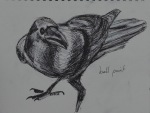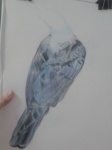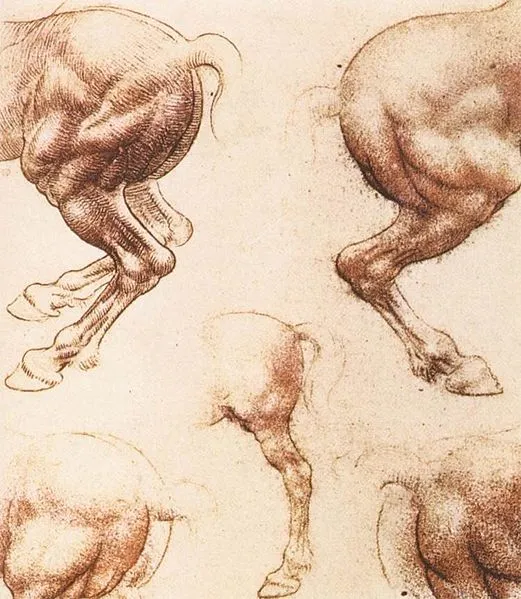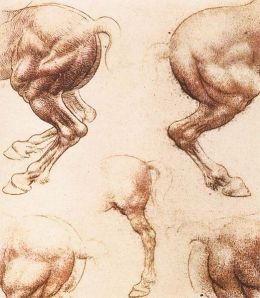Overall Comments
You have maintained a very high standard in the work you have produced for part two of this module Mark. I can see that with every new process and experimentation an even greater and more concentrated progress will occur in your practice. If you maintain this focus you will notice that your output will go from strength to strength.
Feedback on assignment Demonstration of technical and Visual Skills, Quality of Outcome, Demonstration of Creativity
Assignment Two brings together the skills you have attained from experimentation with different coloured media, the manner and method in which you use them and focuses on their suitability to subject matter and the size and format of your finished piece. It also puts you in the position of getting used to confidently employing methods in the arrangement of interesting compositional constructions and refining your ability to render form with accuracy.
The subject you have chosen was undoubtedly an emotive one. Often these heartfelt themes can produce touching imagery and you have successfully done so with this piece. Firstly, I was greatly encouraged to see that you had diligently worked on multiple preliminary studies for the composition and had made detailed and clear annotation with regards ideas and working methodologies. The subtle colour palette utilised has a poignancy that works very well within its compositional arrangement. I was pleased to see that you had really thought about the narrative of the set up and had not fallen back on a conventional still-life arrangement. The placement of the still-life in a bathroom setting with its reflective surfaces of mirror, white ceramic tiles and porcelain basin was also a nice touch. This has strengthened the end result and added a tender feel to the piece, not to mention the inclusion of roses, which have an obvious relevancy. To be honest I feel your choice of working on white paper has worked for you – a coloured support would have made the drawing appear overworked and would have contradicted its intrinsic mood of sensitivity and restraint. It was good to read that you had used the influence of Antonio López García, an artist whose work I greatly admire. There is some very nice drawing here Mark. The delineation of form and reflective surfaces in details such as the tap and the apricot-coloured vase is very effective, as is your utilisation of the compositional device of the rule of thirds – a very well-considered piece.

I have to admit I had never heard of the rule of thirds until now but now at least I can put an artistic phrase to it.

Learning Logs or Blogs / Critical essays Context
Just as in assignment one the learning log has been kept up-to-date meticulously and outlines your thoughts and discoveries scrupulously. It is a breath of fresh air to read your thorough investigation into the research points with regards your chosen artists. I read with great interest your piece about Eliot Hodgkin, an artist whose work I did not know – what a wonderful discovery. As you have suggested, his compositions and depictions of what some may call ‘mundane’ subjects, opens ones’ eyes to the beauty of simplicity. It also confirms that there is beauty in the everyday or commonplace. I can see the inspiration for your leaf drawing. I think you may find working with tempera interesting Mark. If you can’t find any, try gouache which has a similar finish and is more readily available and equally wonderful to work with.
I was hoping to try and put off tempera, gouache and any other paint mediums until the Practice of Painting Course but I made a promise to myself that I would try to get to use either one or the other by the end of this course.
Sketchbooks
You have delivered an impressive amount of work for your sketchbooks Mark. Your adherence to the exercises within this part of the module is admirable and a high quality of work has been maintained throughout. What I find particularly encouraging is your willingness to experiment not only with a diversity of media but also the manner in which it is manipulated. There are many good examples here and I will not mention them all: I especially liked your experiments with dip pens and markers – these display a demonstrability of eye and hand and what appears to be a natural sense for composition. I will also mention that, just as exemplified in your assignment piece, you have a knack for using colour in a way that is sympathetic to your subject, in this case, one that is fearlessly vibrant. The ‘Still-life group using line’ drawing and the study of the dying leaf in stipples and dots also show a considerable dexterity with ink as a medium.
I have to disagree with some of this, I really want to work with dip pens but I feel that I am lacking any reasonable amount of control with them and it is something I working hard to change. It was my effort with the marker pens and applying ink using a brush that made my dip pen work look good.

The leaf in stipples and dots however remains one of my favourite pieces and one that I am very proud of, It reflects the crispness of Elliot Hodgkin’s paintings as researched in the research point in this part.

I am sure the benefits of living in an exotic country are numerous but one that stands out is the wonderful fruits to choose from when setting up a still-life – obviously the watermelon and apple in the ‘Drawing using oil pastel’ exercise are recognisable but the gno is wonderful, reminding me a little of a sea urchin. The piece you have produced for this exercise displays good balance both in terms of colour palette and composition. It is a strong and lively piece and you have successfully proven that you are willing to experiment with new, untried media. The form of each fruit and its overall perspective has been effectively rendered and considered and, generally speaking, possesses a believable compositional balance. The inclusion of the yellow cloth is a bold pronouncement but works perfectly well with the overall colour palette. The detail of the diagonal folds in the cloth in the foreground is also a nice touch as it balances the slightly left-handed arrangement. If I were to be picky however, there are things worth looking at: there is a minor inaccuracy with regards the ellipse of the plate, most noticeable at the rear edge as it disappears behind the watermelon and apple and the shadow cast could have done with a slightly darker rendering; the delineation of the reflection of the apple on the plate needs closer observation – the dark hard line and the highlight next to it in the reflection has created the appearance of a dip in the surface of the plate. Having said all that I feel this piece shows a keen observational ability and an encouraging competence in handling new media.
Again this is another piece that I feel strongly about and would like to submit it for assessment. What I let myself down on here is that I did not make any sketches of other compositions so it may be wise to make more sketches and if necessary redo the piece.
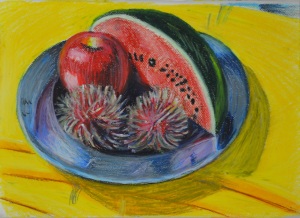
The only piece I felt didn’t quite have the strength of the aforementioned drawings is the study of roses and orchids in a vase, in both colour pencil and crayon and oil pastel. My problem with it is not necessarily the handling of the media, although both examples don’t display the same confidence or strong delineation of light and shade as the others, I feel that in comparison it is its less considered composition. The close cropping or the lack of ‘breathing space’ around the arrangement needs closer scrutinisation.

This is a piece that I am hoping I will have the time to redo. However, I already took what I didn’t like about this composition and used what I learnt from it for my second assignment so is it really necessary?
Suggested viewing/reading Context
It is clear that you thrive on researching the work of other artists and enjoy the process that entails. My only suggestion would be to continue doing this as it obviously has a beneficial effect on your work. With each new discovery, a new direction will open up for you. Keep up the gallery visits too!
Pointers for the next assignment
The next part of this module is about the outdoors and I’ve noticed you have already made a good start on the work. Try, as much as you can, to work from life rather than from photos. Although you have a keen eye and a good visual understanding of space and form it is always good practice to work directly from three dimensions. This will add an even greater perspective to your work.
I understand your aim is to go for the Painting/ Creative Arts Degree and that you plan to submit your work for assessment at the end of this course. From the work you have shown in this assignment, and providing you commit yourself to the course, I suggest that you are likely to be successful in the assessment.










































